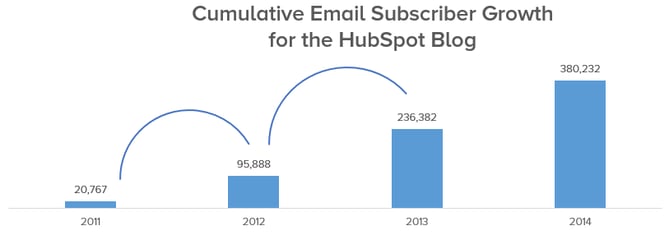There’s a lot to say when it comes to how to do email marketing well.
We could talk for days about the most critical components of an optimized email, common email marketing mistakes you might be making, and examples of brilliant email marketing that will inspire you.
But at the end of the day, it doesn’t matter how optimized your emails are if you can’t see the results of your efforts — not to mention measure whether email is helping you hit your goals.
So before sending your next email, pause for a few minutes and ask yourself: “What is the goal of my email marketing?”
Let’s take a look at the metrics you should be paying attention to in your email marketing efforts. We’ll start with the metrics every email marketer should be tracking, and then we’ll take a look at how to tie certain metrics to your specific goals.
Email Marketing Metrics
- Clickthrough Rate
- Conversion Rate
- Bounce Rate
- Overall ROI
- Open Rate
Overall ROI
- What It Is: The overall return on investment for your email campaigns. In other words, total revenue divided by total spend.
- How to Calculate It: [($ in additional sales made minus $ invested in the campaign) ÷ $ invested in the campaign] * 100
- Example: ($1,000 in additional sales – $100 invested in the campaign / $100 invested in the campaign) * 100 = a 900% return on investment for the campaign
This is the most basic formula to calculate ROI — but there are several ways to approach calculating the ROI of your email campaigns. Depending on your type of business, you might prefer a different one.)
As with every marketing channel, you should be able to determine the overall ROI of your email marketing. If you haven’t yet, set up an SLA system whereby you assign different values to various types of leads based on their likelihood to generate revenue for your company.
According to Campaign Monitor, “For every $1 spent, email marketing generates $38 in ROI.” The average return varies according to the kind of email you’re sending (B2B, B2C, permission-based, non-permission-based), but nearly every statistic about email ROI makes it clear: email is one of the most lucrative and cost-effective channels for business development. Of course, you’ll never generate that kind of ROI if you don’t understand what drives email marketing success… or worse, if you don’t do it at all.
How valuable is ROI?
How many of each of these types of leads did you generate via email marketing? How does this translate to potential revenue? Actual revenue? These are the types of metrics that will help you show your boss and your sales team how valuable email marketing is as a channel that drives real, tangible results.
How to Know Which Email Metrics to Track, Based on Your Goals
The goal of your email marketing may be very different from the goals of another company like yours, and may even vary within your own company over time. But again, it’s crucial that you determine exactly what it is you’re looking to achieve with your email marketing before you begin (or continue) to send and measure your emails.
Here’s how you can align your specific goal with key metrics.
Subscriber List Growth Rate
If your focus is on growing the top of your funnel — attracting more visitors to your site, signing up more blog subscribers, getting more people to use your free tools, that kind of thing — your goal will probably be growing your subscriber list. Your emails will likely contain calls-to-action such as “Subscribe to Our Blog” or “Join Our Weekly Email List.” So of course, the most important metric you should be tracking for this goal is the growth rate of your subscriber list.

Unengaged Subscribers
Just as you want to track and grow your subscribers, it’s also important to keep an eye on your unengaged subscribers — and consider removing them from your list altogether. Why? Because sending emails to people who aren’t engaged with your emails (called “graymail”) can hurt the deliverability of your email overall. Email clients might get tipped off by low engagement rates and deliver email from known-graymail senders straight to recipients’ “junk” folders, meaning your emails will technically get sent and delivered, but won’t necessarily be seen.
Number of New (or Total) Leads Generated
Maybe instead of focusing on subscribers, you’d like to work on growing lead generation. If this is the case, you should be sending emails that offer lead generation content — in other words, content that requires the viewer to fill out a lead capture form in order to access it.
If the goal of your email marketing is lead gen, you should be tracking how many leads you’re capturing every day, and every month. You can decide to focus on all leads generated, or only new ones added to your database, depending on your priorities.
Lead-to-Customer Conversion Rate
Finally, let’s say you want to focus more toward the middle/bottom of your marketing funnel, and convert more of your existing leads into customers. If this is your goal, the emails you’re sending will likely provide content more closely related to your business and your product or service. Your calls-to-action may include “Get a demo,” “Watch a Video of Our Product in Action,” or “Start a Free Trial.” If this is your goal, you should be tracking changes in your lead-to-customer conversion rate.
As obvious as this all seems, you’d be surprised how many email marketers determine their goals and then don’t bother to track their progress against them. Make sure that you’re able to track how closely you’re trending toward your goal at any point during the month, and that you’re looking carefully at any changes in these metrics month over month.